The Unicist Logical Approach to Businesses
The unicist logical approach made possible the development of methodologies and technologies to manage businesses as complex adaptive systems.
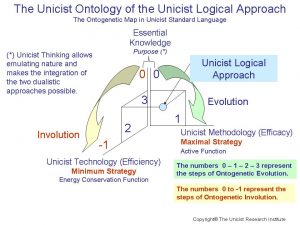 This approach is based on integrating the essential knowledge of an activity and the environment, the use of a unicist methodology that sustains the efficacy of the business processes and the development of unicist object driven technologies that allow managing efficiency without losing the capacity to adapt.
This approach is based on integrating the essential knowledge of an activity and the environment, the use of a unicist methodology that sustains the efficacy of the business processes and the development of unicist object driven technologies that allow managing efficiency without losing the capacity to adapt.
The essential knowledge requires managing the concepts that underlie a business and its environment which allows defining the nature of the business. It requires managing the structure of concepts and being able to transform such concepts into actions.
The Unicist Methodology allows building the maximal strategy of the unicist logical approach. It sustains the efficacy of actions and is based on using logical methods, having the necessary reliable knowledge and doing the corresponding destructive and non-destructive tests to confirm the functionality of such logical methods to expand the boundaries of a business.
The Unicist Technology allows achieving efficiency in businesses which sustains their minimum strategy. The unicist approach to efficiency includes installing a learning capacity in the business systems to make them adaptive to increase the accuracy of the focus of their actions. It also includes the use of an objects driven organization model to increase the level of reliability of the organization, save energy and catalyze the achievement of results.
The Unicist Technology Spin-offs include all the unicist logic based and object driven technologies that can be managed with adaptive automation. This requires providing the unicist technologies installed as systems or adaptive interfaces.
The main technologies that are available are:
Object Driven Reliability • Object Driven Marketing • Adaptive CRM for B2B Markets • Adaptive CRM for B2C Markets • Global/Local Virtual Marketplaces • Unicist Market Lab • Unicist Innovation Lab • Adaptive Business Robots • Unicist Business Objects • Object Driven Organization • Unicist Scorecard • Fundamental Analysis for Banks • Object Driven Business Strategy • Object Driven Virtual Collaboration • Adaptive Business Architecture • Adaptive IT Architecture • Object Driven Continuous Improvement • Unicist Project Management • Object Driven Diagnostics • Object Driven Knowledge Management • Object Driven Talent Development • Object Driven Superior Education • Teaching Hospitals in Business • In-company Corporate Universities • Conceptual Economy • Country Future Scenarios •
About Essential Knowledge
The unicist logical approach allowed transforming the essential knowledge of businesses into reasonable, understandable and provable knowledge. This is a scientific approach to organizational behavior and business processes in order to manage them based on the knowledge of their fundamentals and the technical (systemic) knowledge.
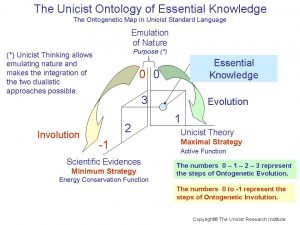 The discovery of the ontogenetic intelligence of nature made the emulation of nature possible. It allowed managing the dynamics of businesses as adaptive systems.
The discovery of the ontogenetic intelligence of nature made the emulation of nature possible. It allowed managing the dynamics of businesses as adaptive systems.
The unicist logical approach is driven by the emulation of nature. This implies a structural approach to businesses responding to their nature. The concepts of businesses define their fundamentals which drive their actions.
The Unicist Theory provided the framework to deal with complex adaptive systems. It is based on a unicist ontological approach that describes the nature of adaptive systems based on the unicist ontology that emulates the ontogenetic intelligence of nature.
The knowledge that is produced using the unicist theory is reliable due to the integration of fundamental knowledge and technical-analytical knowledge and the use of destructive and non-destructive tests.
The evidences of the Unicist Theory sustain the validity of the theory. This theory is applicable to all those adaptive environments and entities in which it is possible to confirm the validity of the knowledge of their essential structures.
Learn more: http://www.unicist.org/repo/#Basics
The use of the unicist logical approach to businesses allows going beyond empiricism and utilizing on the one hand, a logical methodology to develop maximal strategies and, on the other hand, object driven technologies to manage minimum strategies.
About the Unicist Methodology
The unicist methodology is based on the use of logical methods that are defined by the ontogenetic maps of the business functions. These ontogenetic maps define the fundamentals of these functions and the steps for their construction and integration.
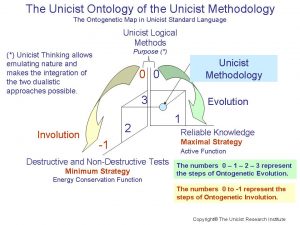 The construction of business solutions using the unicist methodology requires beginning with the development of maximal strategies, which allow expanding the boundaries of the functionality, and completing the construction with the building of minimum strategies, which sustain the “survival” of the functions.
The construction of business solutions using the unicist methodology requires beginning with the development of maximal strategies, which allow expanding the boundaries of the functionality, and completing the construction with the building of minimum strategies, which sustain the “survival” of the functions.
This methodology is based on having the necessary reliable knowledge that allows building these solutions. Reliable knowledge is defined by the integration of technical-analytical knowledge (systemic) and the knowledge of the fundamentals (conceptual).
The use of destructive and non-destructive tests is the way to confirm the functionality of the knowledge and sustain the logical method to build solutions.
The destructive tests provide the limits of the functionality of a specific knowledge while the non-destructive tests define the validity of this knowledge in order to structure solutions.
The destructive and non-destructive tests are the catalyst of the unicist logical approach to business. But it needs to be considered that while the existence of these tests accelerates the development of solutions that emulate the organization of nature, their inexistence inhibits the development of such solutions.
The logical methods define the steps that need to be followed, the functionalities of each entity that is being organized and the thresholds that need to be achieved by each function.
About the Unicist Technologies
Unicist technologies are provided as adaptive automated systems based on encapsulated business processes and the use of object driven organization. These technologies provide the system that sustains the efficiency of businesses in adaptive environments.
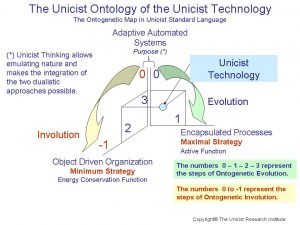 These technologies transform the logical methods into systems in order to simplify the processes following the nature of each function.
These technologies transform the logical methods into systems in order to simplify the processes following the nature of each function.
The processes that are encapsulated are built and tested using the necessary destructive and non-destructive tests in order to become fully reliable. They include a quality assurance entity that allows confirming their functionality and the necessary alternative actions when the changes in the environment exceed the possibilities of their adaptiveness.
The use of the Object driven Organization sustains the functionality of the adaptive automated systems. It requires using all the types of objects to sustain the process:
- Gravitational objects
- Catalyzing objects
- Entropy inhibiting objects
- Driving objects
- Inhibiting objects
Multiple objects were developed to be included as part of the unicist technologies:
http://www.unicist.org/business-objects.php
Levels of the Unicist Technologies
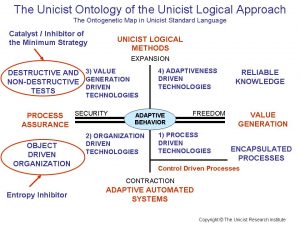 The level of adaptive technologies used in a business defines its level of adaptiveness and its capacity to grow. The higher the level of adaptiveness, the higher the capacity to grow and to generate profits in an environment.
The level of adaptive technologies used in a business defines its level of adaptiveness and its capacity to grow. The higher the level of adaptiveness, the higher the capacity to grow and to generate profits in an environment.
Five levels of unicist technologies for businesses have been defined:
- Control driven processes
- Process driven technologies
- Organization driven technologies
- Value generation driven technologies
- Adaptiveness driven technologies
Level 0) Control driven processes
Control driven logical approaches are based on the establishment of business processes that follow the needs of the goals to be achieved but are not based on the nature of the processes or the environment.
This approach ensures the results based on controlling processes and incentives. It does not allow developing maximal and minimum strategies and is based on a hierarchical business architecture.
Level 1) Process driven technologies
This is actually the first level of unicist logical technologies for business. It requires organizing processes based on their concepts, which allows encapsulating such processes while sustaining their adaptiveness.
Process driven logical approaches are based on the use of the unicist scorecard to measure the results of each process in order to confirm its functionality.
The adaptiveness of these technologies is focused on the functionality of individual processes.
Level 2) Organization driven technologies
This level includes the preceding level. It is based on the use of the unicist objects driven organization model which includes unicist objects of any kind and the organization of roles in order to define the responsibilities to achieve results.
It includes the use of the unicist scorecard to measure the functionality of the roles included in the organization. This level of technology allows short-term planning.
The adaptiveness of these technologies is focused on the functionality of the roles of an organization.
Level 3) Value generation driven technologies
This level includes the preceding level. It is focused on the generation of value based on the strict use of destructive and non destructive tests and the use of a continuous improvement technology.
This level of technology manages the dynamics of the processes based on the functionality of the concepts of the business and not only of the processes or roles.
The unicist scorecard measures the functionality of the business including customers / clients, shareholders and stakeholders. This level of technology allows middle-term planning.
The adaptiveness of these technologies is focused on the value generation of an organization.
Level 4) Adaptiveness driven technologies
This level includes the preceding level. It is based on a dynamic approach to the environment and the use of the fundamental and technical knowledge to improve the adaptive aspects of the processes and the use of the logical methods to empower their adaptiveness.
Adaptiveness is driven by a continuous learning process of the organization which requires having adaptive automated systems.
As adaptiveness improves the focus of actions, these organizations have a significant capacity to grow and generate results simultaneously. Their unicist scorecard manages businesses as a unified field which allows long-term planning.
The adaptiveness of these technologies is focused on the functionality of a company as a unit.
Conclusion: Unicist Object Driven Technologies
The Unicist Object Driven Technologies provide the framework that allows institutions and companies to organize growth measured both in terms of market share and profits.
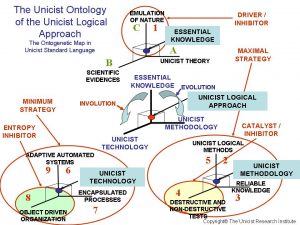 It is build upon the functions, roles and objects defined using the unicist logical methods. It allows building a business architecture that follows the lowest energy consuming actions of nature.
It is build upon the functions, roles and objects defined using the unicist logical methods. It allows building a business architecture that follows the lowest energy consuming actions of nature.
The use of destructive and non-destructive tests is the catalyst of the development of object driven technologies while the object driven organization inhibits the entropy of this model by introducing unicist objects.
Unicist objects are adaptive systems in themselves that guide the processes minimizing the energy consumed and increasing the results obtained.
The introduction of unicist technologies drives towards an upgrade and simplification of a business. The unicist technologies drive towards simplicity in businesses.

